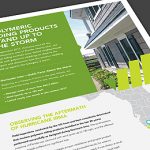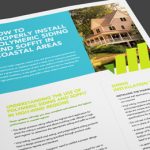The Top 5 Resilient Advantages of Vinyl Siding
There are several reasons why vinyl siding has been the top cladding selected for home building projects for the last 25 years.
We have dedicated a lot of blog space over the past year creating greater awareness about the sustainable benefits of polymeric siding, and builders and specifiers have become more familiar with vinyl’s great versatility for a wide range of architectural designs – especially for traditional neighborhoods.
And there’s a good reason why: for the past quarter-century, vinyl siding has been the #1 choice for building new single-family homes because of its superior durability in handling the most extreme climates and weather events.
Here are the top five resilient advantages of vinyl siding that all home builders should know about:
- Vinyl Siding Offers Wind Resistance. Product certification has enabled the industry to test and verify the ability of products to withstand winds of 110 mph or more. The design of the nail hem, in most cases, is what makes vinyl siding stronger – in fact, strong enough in certain scenarios to be used in Miami-Dade County, Florida, a High-Velocity Hurricane Zone. Proper installation of suitably designed products can withstand storm and even hurricane conditions.
- Vinyl Siding Delivers Superior Moisture Management. Vinyl siding is a top-performing product for both humid climates and cold climates (where it has no freeze-thaw issues attributable to most other claddings). It is immune to moisture damage and helps a home’s wall breathe and dry out. Think of vinyl siding as “vented cladding,” whereas many other exteriors are “absorptive cladding.” Unlike other exteriors, you do not have to paint or caulk the vinyl material to protect it from water absorption.
- Vinyl Equals Low Fire Risk. Vinyl siding does not contribute to the growth of fire (in fact it can be used with fire rated assemblies) – making it ideal for home building and remodeling in both urban-wildland interfaces and high-density buildings. Vinyl was first introduced to the market as a replacement for cloth sheathing for electrical wire. Because it’s chlorine-based, vinyl siding is inherently flame-retardant and does not ignite quickly. The results of an ASTM E162-06 test (the Standard Test Method for Surface Flammability of Materials Using a Radiant Heat Energy Source) have revealed that PVC – the primary ingredient of vinyl siding – does not release a lot of energy when it burns and will not readily spread flames on its own. Accordingly, vinyl siding has been approved for use in all types of construction including non-combustible construction.
- Vinyl Is Designed to Resist Water Intrusion. In each of the past four years, the Atlantic hurricane season has experienced above-average activity. Because of its immunity to water absorption and moisture damage, polymeric siding can be ideal in coastal construction where structures must be designed and built to withstand flood events. In fact, vinyl siding has been recognized by several national programs, including FEMA, as a recommended cladding to “successfully protect homes and function adequately within a coastal environment if properly installed.” These recognitions will be beneficial for driving increased usage of polymeric siding for home building and remodeling in coastal areas.
- Excellent Color Retention. Thanks to the rich formulation and co-extrusion process, vinyl siding has a UV protectant cap stock such as acrylics – the same material used in the red brake light on your car. Certified vinyl siding color options have been tested for color retention and undergo rigorous outdoor exposure testing to ensure durability. Paints used for other materials like wood and fiber cement require regular maintenance. The 400+ vinyl siding colors are certified for trusted protection against fading, and they won’t chip or peel like paint. I recently learned about a neighbor in my hometown outside of Buffalo, NY, who spent $10,000 repainting his house last summer. I then recalled a recent conversation I had with longtime-VSI consultant Fernando Ruiz (when we were discussing the strong industry reaction to the new VSI Architectural Design book that he co-authored), in which he told me that vinyl siding is becoming more prevalent in the snow belt because people are tired of scraping paint.
Some Final Thoughts
There are even more durable benefits of polymeric siding, including termite resistance – which is essential for homes in warmer climates where termites thrive. What was once dismissed as cheap plastic long ago has been the top cladding for new projects since the mid-1990s, with the largest market share in the Northeast and Midwest.
And as builders, specifiers and homeowners across North America become more familiar with vinyl siding’s sustainable and design advantages, they will be sure to tell you why they love the cost-effectiveness the most: the durability.
Don Browne is a writer, entrepreneur and local legislator who believes that the power of words can change the world. He provides unique writing services for clients in the construction, health care, IT and hospitality sectors. He has a passion for small business and start-ups, as well as writing about Irish history, family and corporate biographies. As a homeowner and father of four who is passionate about community development, Don looks forward to writing more about the exciting possibilities of creating traditional neighborhoods and more sustainable communities using modern materials.


